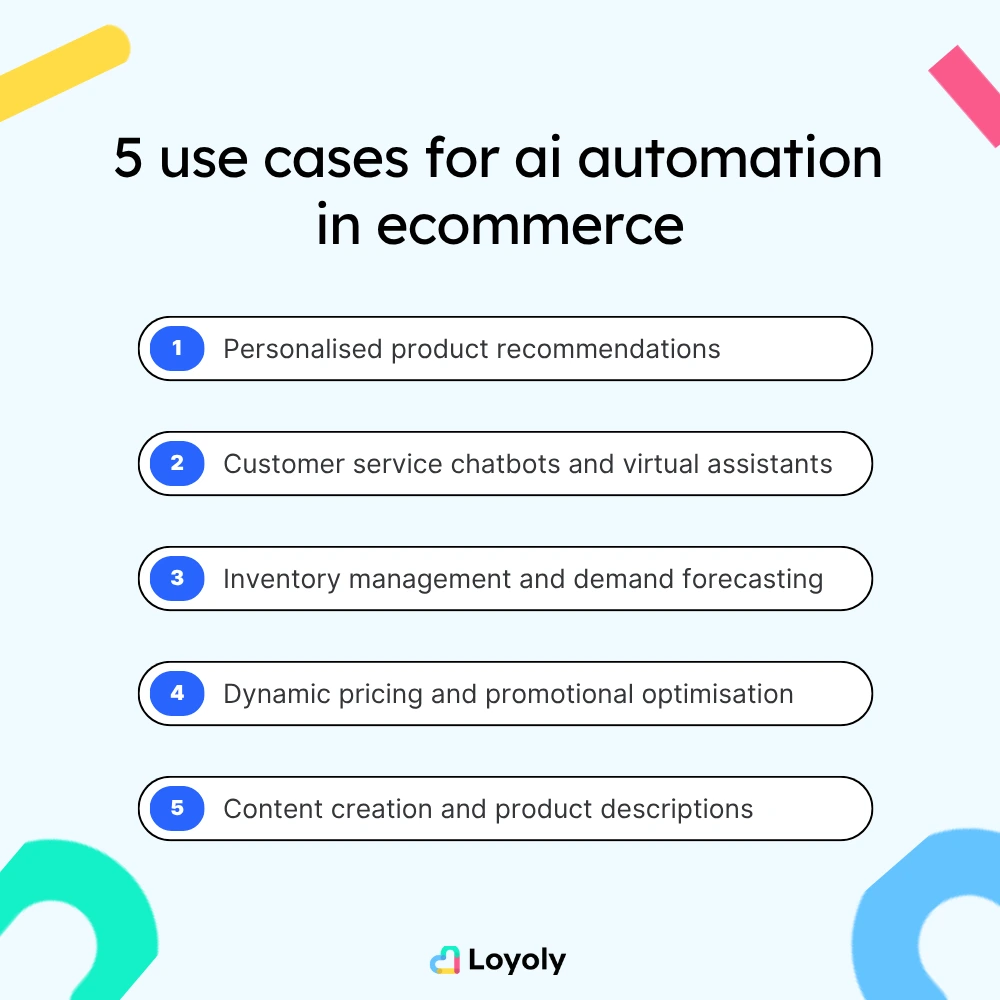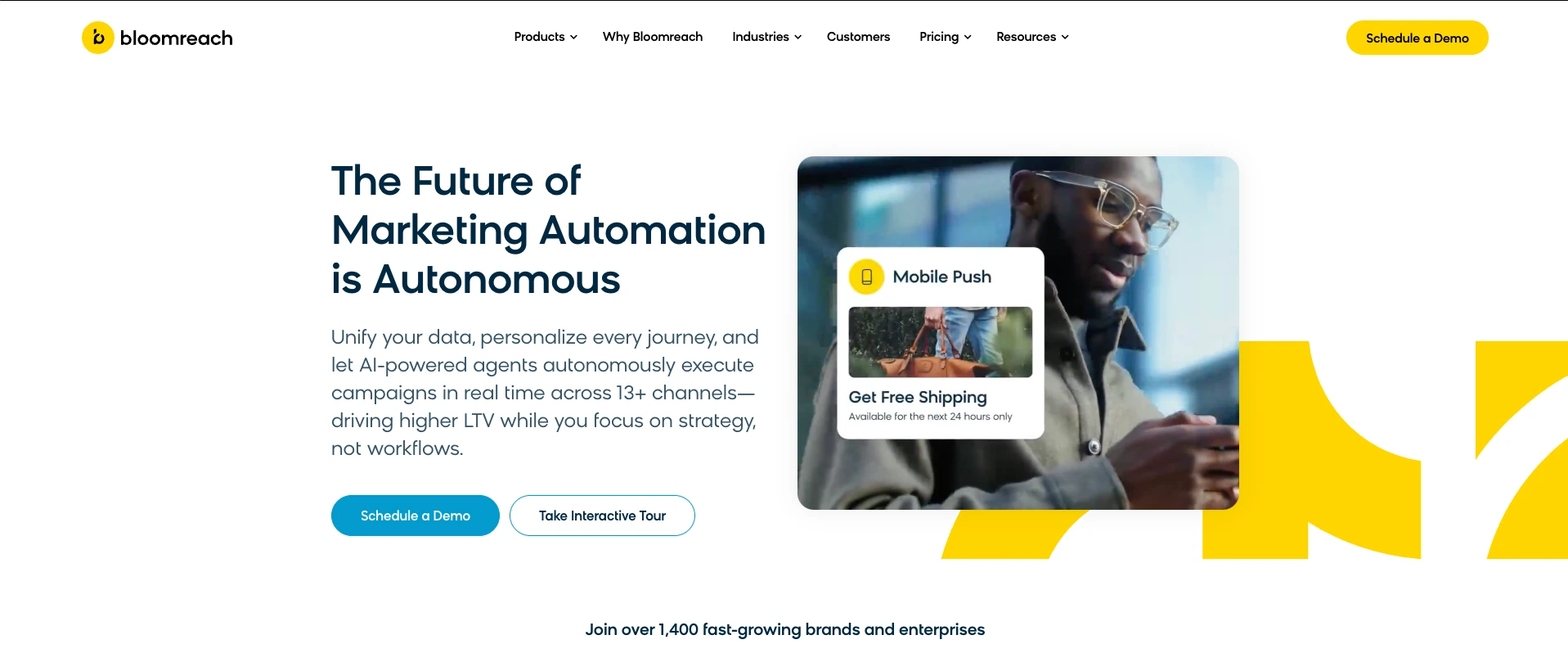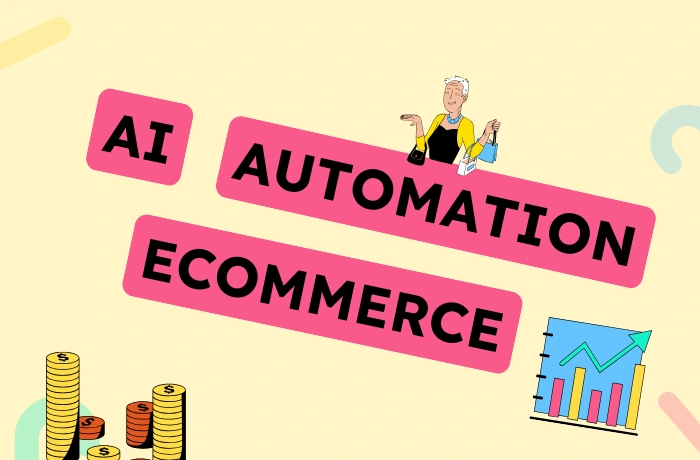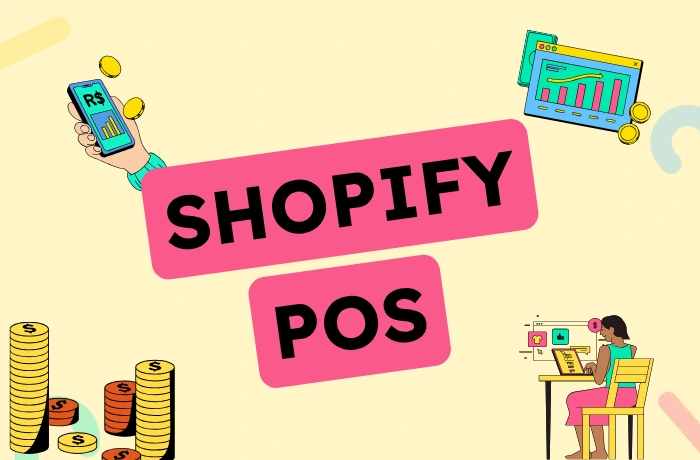If you're running an ecommerce brand in 2025, you've probably heard a lot about AI.
But beyond the buzzwords, something real is happening.
AI automation is quietly changing the way online shops work, grow, and connect with people.
It’s not just about saving a few hours here and there. It’s about making smarter decisions, faster, and at scale.
In this article, we’re going to break down what AI automation actually is, how it’s different from the usual automation workflows you might already use, and how all the tech behind it fits together.
Let’s get into it.
What is AI automation for ecommerce?
AI automation is what happens when artificial intelligence meets your daily ecommerce operations. Instead of relying on manual rules or fixed workflows, you plug in tools that learn from your data, adapt to how shoppers behave, and help you make better decisions on the fly.
This could mean smarter product suggestions, more relevant marketing campaigns, or better stock management without the back-and-forth.
It’s not about replacing your team. It’s about giving them tools that think and act faster than any spreadsheet ever could.
How it differs from traditional ecommerce automation
Let’s keep it simple.
Traditional automation runs on rules.
If someone abandons their cart, send them a reminder.
If stock drops below 10, notify the team.
It works, but it doesn’t adapt.
AI automation, on the other hand, learns from what’s actually happening.
Instead of waiting for triggers, it predicts them.
Instead of showing every visitor the same offer, it tailors the message based on what that person is likely to want.
That’s the big shift.
Traditional automation helps you do the same things faster.
AI automation helps you do better things, full stop.
👉 Discover the complete guide to automation in eCommerce in our article.
How AI, machine learning, and automation work together
These terms often get mixed up, but they each play a different role in how modern ecommerce automation works.
Artificial intelligence is the decision-making engine.
It processes large sets of data, identifies patterns, and helps systems make choices that feel smart and relevant.
Machine learning is what powers that intelligence over time.
It allows the system to improve as it’s exposed to more data, without needing to be manually updated.
👉 Our article breaks down all the essentials of machine learning in ecomemrce for you.
The more your platform learns, the more accurate and effective it becomes.
Automation, on the other hand, is where action happens.
It’s the part that executes the task, whether that’s sending an email, updating stock, or triggering a campaign.
Without automation, insights stay locked in your data.
Here’s how it comes together.
AI processes your customer behaviour.
Machine learning recognises buying patterns and suggests what’s likely to work best next.
Automation takes that insight and delivers the right message or action at the right moment.
Each layer plays its part to help your business make decisions faster, serve customers better, and grow more efficiently.
👉 We explain everything you need to know about ai in ecommerce in our article.
Why AI automation matters for ecommerce businesses
AI automation has gone from a buzzword to a real game-changer for online retailers.
It's not just about making life easier behind the scenes, it's about creating better shopping experiences and running a smarter business overall.
In a market where speed, relevance, and personalisation can make or break a sale, automation powered by artificial intelligence is quickly becoming a competitive edge.
Let’s dig into what that actually means in practice.
How AI boosts customer experience and conversions
In ecommerce, customer experience plays a massive role in driving sales.
When someone lands on your site, they expect speed, relevance, and a smooth path to checkout.
AI helps deliver just that, by adapting the journey to each shopper in real time.
Imagine landing on a homepage that instantly highlights the products you're most likely to want, based on your previous visits or buying behaviour.
Or receiving an email that doesn’t just mention a discount, but calls out something you’ve looked at recently.
That kind of personalisation feels seamless, and it works.
AI can also improve live support with chatbots that respond instantly, guide users through their journey, and solve basic issues without delay.
All of this leads to a better experience and, ultimately, more conversions.
With AI, you’re not pushing offers at random.
You’re responding to actual customer signals, which means more relevance, better timing, and a higher chance of turning visits into purchases.
Why leading ecommerce retailers are investing in automation
There’s a reason the biggest players in the industry are going all-in on AI automation.
It’s not just about streamlining operations : it’s about unlocking growth opportunities that manual processes can’t keep up with.
Retailers are using AI to better predict demand, manage inventory more efficiently, and avoid the all-too-common issues of overstock or stockouts.
They’re also making smarter marketing decisions by identifying which segments are most likely to convert, when to reach them, and with what message.
Instead of spending hours combing through data, teams can focus on strategy while AI handles the heavy lifting.
Companies like Amazon and ASOS aren’t just ahead because of their size, they’re ahead because they automate intelligently.
5 use cases of AI automation in ecommerce
AI is no longer just a buzzword.
It’s already powering some of the most effective tools in the ecommerce world.
Whether you’re trying to improve customer journeys, fine-tune your marketing, or streamline your operations, AI automation brings practical value to every part of your business.
Here are five key ways retailers are using AI to get better results every day.

Personalised product recommendations
Product discovery has become a major growth lever for online shops.
AI makes it smarter. Instead of showing the same items to everyone, AI-powered recommendation engines analyse browsing habits, order history, and real-time activity to suggest products that truly match what each user is looking for.
This personalisation creates smoother shopping experiences and leads to more conversions.
Customers spend less time searching and more time adding to cart, which means higher average order values and better retention.
Customer service chatbots and virtual assistants
AI chatbots are now a core part of modern customer service.
They’re fast, available at any hour, and able to handle a wide range of questions, from tracking orders to recommending the right product based on preferences.
The biggest benefit is consistency.
These assistants don’t get tired or make mistakes.
They use your existing data to provide instant support while freeing up your team to focus on more complex cases.
For any retailer managing hundreds of requests a day, it’s a serious time-saver and a big win for customer satisfaction.
Inventory management and demand forecasting
Stockouts and overstocking are costly mistakes.
AI helps retailers avoid them by analysing past sales, current trends, and seasonal patterns to predict future demand more accurately.
This leads to smarter restocking decisions and more efficient inventory planning.
Instead of reacting when something runs out, AI tools let you plan ahead.
You know what to expect, what to order, and when to move inventory.
It’s a more reliable way to manage stock, especially when product demand changes fast.
Dynamic pricing and promotional optimisation
Pricing used to be static and updated manually.
AI changes that by helping you adjust prices in real time based on multiple factors like customer behaviour, competitor pricing, time of day, or even stock levels.
Retailers also use AI to test different types of promotions and find the ones that deliver the best results.
Whether it’s a percentage off, a bundle deal, or a time-limited offer, the system tracks performance and adapts on the fly.
It’s a way to stay competitive while protecting your margins.
Content creation and product descriptions
Writing product descriptions can take hours, especially when you have hundreds of items to list.
AI tools help automate this task by generating SEO-friendly descriptions that match your tone of voice and highlight the right features.
This kind of automation speeds up the process without sacrificing quality.
It also makes it easier to test different versions of content and see which ones convert best.
For growing online shops, this is a simple but powerful way to save time and boost performance.
How to get started with AI automation
Getting started with AI might sound overwhelming, but it doesn’t have to be.
You don’t need a full tech team or a massive budget to begin.
What matters is having a clear plan, choosing the right tools, and moving step by step.
Here’s how to approach it.
Define clear goals before you automate
Before diving into AI tools, start by asking yourself one thing: what exactly do you want to improve? Inventory management? Campaign personalization? Customer support?
If you skip this step, you’ll end up testing tools without any real impact.
Focus on one or two high-value goals and build from there.
Choose tools that fit your ecommerce stack
There’s no one-size-fits-all.
The right tool is the one that fits nicely with your existing setup, doesn’t add complexity, and actually solves a pain point.
On Shopify? Look into native apps or integrations with Zapier or Klaviyo.
Running B2B? CRM platforms like HubSpot or Zoho might be a better fit.
And if you’re working on customer retention, Loyoly integrates with a wide range of tools and helps automate loyalty flows that actually drive repeat purchases.
Pssst... You might find this interesting!
Loyalty programs are strategic for your brand, and we can probably help. Check out our platform!
Start small, track your results, and scale what works
Don’t try to automate everything at once.
Pick a simple use case like sending abandoned cart reminders at AI-optimized times.
Measure the performance, learn what works, and scale from there.
What matters most is building step by step with a test-and-learn mindset.
AI won’t do it all, but when used right, it’s a powerful growth lever.
Tools to kickstart AI automation in your ecommerce strategy
Once you’ve defined your strategy, the next step is choosing the right tools to bring AI automation into your daily ecommerce operations.
The good news? You don’t need to rebuild your entire stack.
Today’s platforms are increasingly accessible, easy to integrate, and focused on improving customer experience, conversion, and retention.
Below are just a few popular options to get started.
This isn’t a shortlist or a ranking : it’s a look at three tools that are already helping ecommerce brands bring more intelligence into their marketing and operations.
Klaviyo
Klaviyo has become a go-to tool for ecommerce brands looking to automate their email and SMS marketing.
While it’s not fully AI-powered yet, the platform is rolling out AI-assisted features that make campaign building faster and smarter.
You can use predictive analytics to estimate customer lifetime value, segment audiences based on behaviour, and optimise send times.
Product recommendations can be personalised using data from past purchases and site activity.
These features are still guided by marketers, but supported by machine learning in the background.
For teams that want more control with an AI boost, Klaviyo is a reliable choice especially for Shopify-based brands.

Shopify Magic
If you're on Shopify, you already have access to a growing range of AI-powered tools under the "Shopify Magic" banner.
These include automated product descriptions, multilingual content generation, and smart suggestions based on customer intent and store data.
Because it’s built directly into the platform, Shopify Magic requires no additional setup or third-party apps.
It’s a simple and low-effort way to test AI automation, especially for merchants who want to save time on repetitive tasks while keeping full control over their storefront experience.

Bloomreach
Bloomreach is a robust AI platform focused on helping ecommerce brands deliver smarter, more personalised shopping experiences.
It combines real-time data, product performance insights, and customer behaviour to power dynamic on-site search, product recommendations, and merchandising.
Its strength lies in turning complex data into actionable recommendations showing the right product to the right customer at the right time.
For larger teams looking to go beyond basic automation and build advanced personalisation into their ecommerce journey, Bloomreach is a powerful and scalable option.

4 things to watch out for before adopting AI automation
As promising as it is, it’s not without its hurdles.
The benefits are real, but so are the complexities.
Before diving in, it’s important to understand what could slow you down or require a more thoughtful setup.
Data privacy and security concerns
AI needs data to be effective, and lots of it.
That’s where things can get tricky.
When you're collecting and processing customer information, even with the best intentions, you’re dealing with serious privacy responsibilities.
Between GDPR, data breaches, and growing user concerns about how their data is used, trust can be fragile.
Retailers have to make sure they’re using tools that comply with regulations and follow strict security protocols.
Customers want personalised experiences, but they also want to know their data is safe.
Finding that balance is one of the first challenges brands face when implementing AI-driven solutions.
Integration complexity with existing systems
Most ecommerce businesses already rely on a stack of tools from CMS platforms and CRM systems to logistics and marketing software.
Adding AI automation into the mix can create friction if the new tools don’t play nicely with the ones you already have.
Some solutions require custom development, API configuration, or major changes to your workflows.
If you’re not working with flexible platforms or a tech team that can manage the integration, things can get messy fast.
That’s why choosing tools built for your specific ecosystem is so important.
Costs and resource requirements
AI tools have become more accessible, but they still come with a price.
Whether it's a subscription model, onboarding costs, or the time needed to train your team, these are resources that smaller businesses sometimes overlook.
It’s not just about paying for the software.
It’s also about making sure you have the right data, the right people, and the right processes to get real value out of the tech.
Without that foundation, the return on investment might fall short of expectations.
Maintaining a human touch
Automating your store doesn’t mean removing the human element entirely.
In fact, the best ecommerce brands use AI to support their teams, not replace them.
But if you’re not careful, over doing it can make your store feel cold or generic.
Customers still want to feel heard, understood, and valued.
Whether it's through community management, personalised messages, or thoughtful after-sales service, the human connection is what builds trust and loyalty.
It should make that easier, not take it away.
3 future trends in AI automation for ecommerce
AI in ecommerce is advancing quickly. What felt like innovation last year is already becoming part of everyday operations. And forward-thinking retailers aren’t just using automation to save time. They’re using it to build smarter, faster, and more personalised experiences.
Here’s a look at the next big shifts already taking shape.
Advanced predictive analytics for better decision-making
Retailers want to stop reacting and start anticipating.
With better predictive tools, businesses can make informed decisions about stock, pricing, and campaigns before issues even appear.
These analytics rely on historical data, real-time performance, and behavioural signals to suggest the next best move.
That might mean restocking a product earlier, adjusting prices based on upcoming demand, or spotting customers who are likely to stop buying.
This level of insight allows teams to plan with more confidence and less guesswork.
Virtual try-ons and immersive shopping experiences
One of the biggest friction points in online shopping is the inability to try things out.
AI is changing that by enabling virtual try-ons and interactive previews.
Whether it’s seeing how sunglasses fit your face or how a sofa looks in your living room, these features help reduce doubts during the buying process.
Shoppers feel more confident when they can visualise the product.
Retailers benefit too, with fewer returns and better customer satisfaction.
As these experiences become easier to implement, expect more brands to add them directly to their product pages or mobile apps.
Increased platform integrations and no-code AI tools
Adopting AI no longer means hiring a full dev team.
The rise of no-code tools and native integrations makes it much easier to start using automation in your business, even with limited resources.
From content generation to campaign optimisation, there are now tools designed to plug directly into popular ecommerce platforms.
That means you can launch and manage smart features without heavy setup or technical delays.
This accessibility is helping more retailers unlock the value of AI, faster and at scale.
How Loyoly can help
If you’re already thinking about AI automation, the next step is making sure your tools can talk to each other.
That’s where Loyoly fits in.
We integrate with a wide range of ecommerce platforms and tools, so it’s easy to connect your loyalty strategy with the rest of your tech stack.
Whether you're using Shopify, Klaviyo, Gorgias or others, Loyoly is designed to plug in smoothly and help you build loyalty programs that actually engage your community.
Our platform lets you automate key parts of your loyalty experience like rewarding specific actions or triggering campaigns without manual work.
In short, if you want to turn your most engaged customers into long-term fans, we make that process a whole lot simpler.

.png)









.png)
.png)
.png)
.png)
.png)